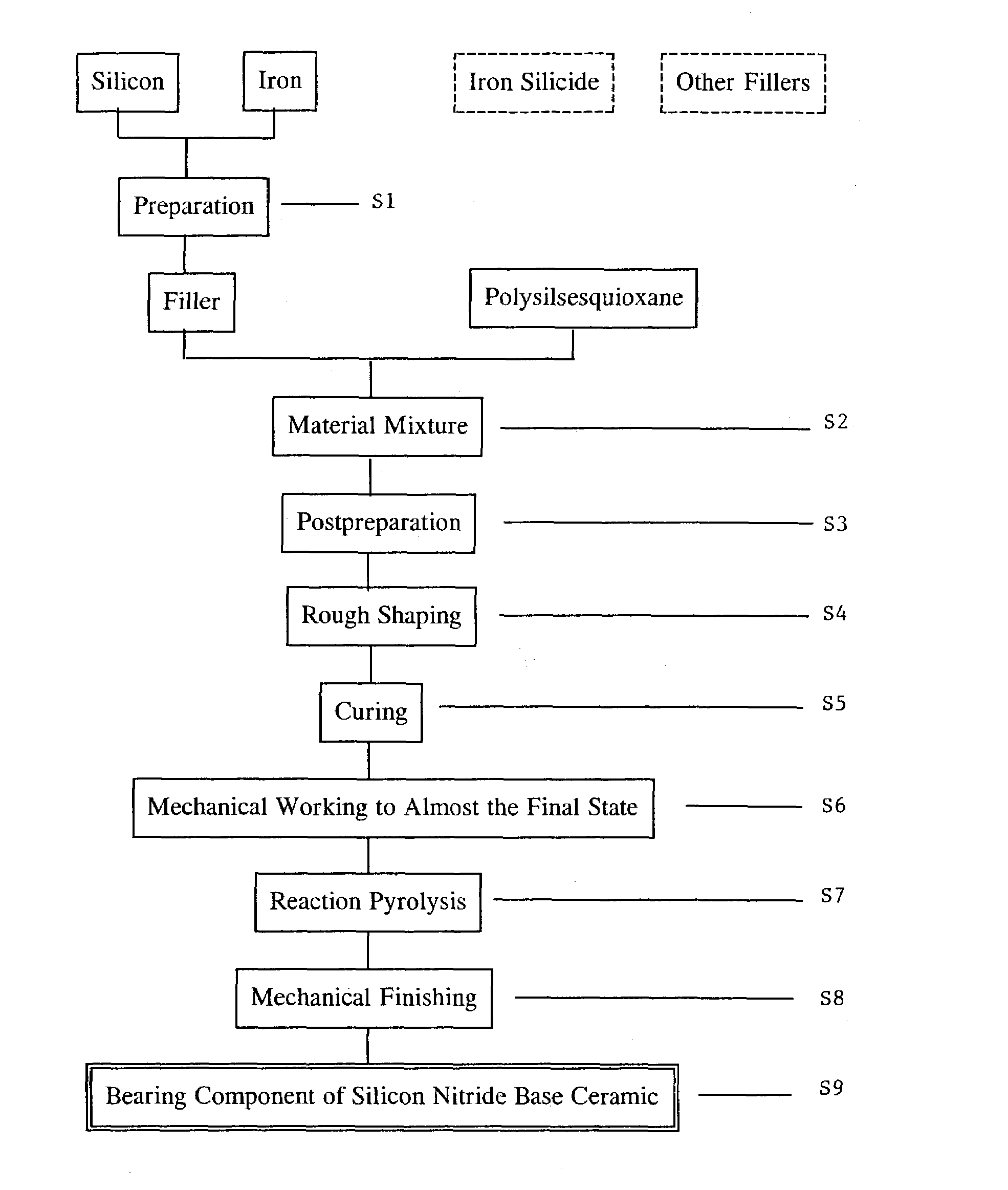[0009]Compared to the previously used
sintering and
hot pressing processes for producing ceramic bearing components, this process proceeds more rapidly. In addition, due to significantly lower temperatures compared to the typical
sintering temperatures for
silicon nitride from 1700° C. to 2000° C., this process requires lower energy usage and much less sensitivity, and therefore decidedly less complex
process control. Moreover the raw materials used are comparatively economical. Also, under suitable
process conditions during pyrolytic ceramicization, hardly any shrinkage occurs, especially for simple shaped bodies, such as for example rolls or balls produced from bars or rods for roller bearings, and larger volumetric changes can also be allowed on a controlled basis.
[0010]The material mixture can contain a cross-linking, organometallic, especially
organosilicon compound, such as for example a
silicone or polysiloxane as the preceramic precursor.
Silicone resins or polysilsesquioxanes and others are especially well suited due to the preprocessing which can be carried out in air (relative invulnerability to
moisture,
hydrolysis stability) and also due to their corresponding availability which makes them comparatively economical. They are available in
solid and liquid form with a varied
viscosity, and over their wide range of compositions, in addition to the
silicon content, allow especially the selection of various carbon and
oxygen proportions.
[0012]Moreover, the material mixture can contain other chemically reactive fillers, for example aluminum (which is economical for forming aluminum
oxide with the
oxygen contained in the
silicone resin). Likewise the material mixture can contain at least one
inert filler which can be processed in
powder form or also as fibers, especially as short fibers. This can help improve the
material fatigue and
wear resistance. In particular,
zirconium oxide and / or aluminum
oxide and / or
silicon carbide and / or
silicon nitride, with the latter also promoting
nucleation of
silicon nitride within the framework of reaction
pyrolysis in the
nitrogen atmosphere, can be added in a finely distributed manner to improve the mechanical properties and / or the reaction
kinetics. By suitable selection of, for example, the filler combination and
pyrolysis conditions (
temperature control and
pressure control, for example in a
nitrogen atmosphere), the shrinkage behavior, the mechanical and electrical properties (especially with an objective of the
conductivity of the resulting bearing components being as relatively low as possible) of the
polymer-derived ceramic can be further optimized quite efficiently. This applies likewise to other material characteristics of the final product, such as the coefficient of
thermal expansion or
thermal conductivity and to magnetic properties. The
chemical composition of the organometallic compound used can also be incorporated into this material optimization.
[0016]Before reaction pyrolysis, initial shaping of the material mixture oriented or configured roughly to the orientation or configuration of the bearing component can be carried out, for example by pressing or
casting and then hardening the organometallic compound which is contained in the material mixture. This stabilization to a
green component as free of pores as possible can take place with or without
weight loss and especially under pressure and by adding heat at a temperature of roughly 100° C. to 300° C. Alternatively or in addition, hardening can also be completed by the action of
radiation or can be promoted by additives. From the standpoint of hardening, a semifinished product of stable shape can be produced from the material mixture, and from it the bearing components can be produced almost in the final state in their dimensions before carrying out the reaction pyrolysis. This has the
advantage that the mechanical working necessary for producing the bearing components takes place for the most part with conventional processes which are customary in the industry, for example by
machining with low
tool wear on the relatively soft
green component and not on the hard, brittle ceramic product. This greatly facilitates working so that efficient and economical production is possible.
[0017]The components of the material mixture can be matched to one another such that the bearing components in the course of reaction pyrolysis are not exposed to any noteworthy shrinkage or generally do not experience a controlled,
low volume change which is tailored to the final finishing. This has the
advantage that the cross-linked
green component can be machined almost to its final dimensions. After carrying out the reaction pyrolysis, mechanical finishing (for example,
grinding,
honing, lapping) of the ceramicized bearing components can be done. But in this case, only a relatively small amount of
material removal is necessary. Particularly in the production of shaped bodies, such as for example rolls and balls for ball bearings made from bars or rods, there can be greater shrinkage or even a volumetric expansion to the desired target size in a controlled manner. To improve the mechanical properties, the ceramic product can be shot-peened before or after mechanical finishing, whereby residual compressive stresses which inhibit cracks are introduced in the edge area.
[0018]To produce bearing components based on
silicon nitride, polysilazanes are fundamentally also suited as the
organosilicon precursor. Their use however, compared to
silicone resins, is typically associated with higher costs for the
raw material and more complex further
processing (to address for example
moisture sensitivity).
 Login to View More
Login to View More 

